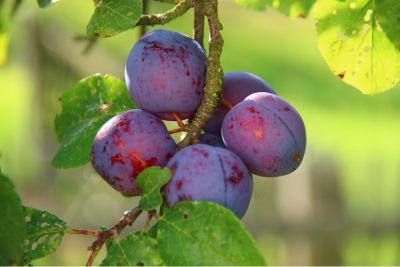
- Appeared when crossing: Giant x Washington
- Growth type: vigorous
- Crown: not thickened, spherical
- Tree height, m: up to 5
- Fruit size: large
- Fruit weight, g: 60-70
- Fruit shape: oval, elongated
- Fruit color: purple
- Skin : thin
- Pulp (consistency): very juicy
Among the huge variety of all kinds of fruit trees, plum crops have recently been gaining popularity. Among them, the not very well-known variety Kirgizskaya excellent stands out. The size and flavor characteristics of these plums are excellent - they are as sweet as many other Asian desserts. In addition, culture is distinguished not only by endurance, but also by unpretentiousness.
Breeding history
The birthplace of the excellent Kyrgyz plum became, as you might guess from the name, Central Asia. The variety is the result of the fruitful work of Kyrgyz breeders. But his parents chose the Americans - the famous cultures of Giant and Washington, from which the Kyrgyz took only the best, for which they called her Excellent.
Description of the variety
Plum trees are vigorous, while they can reach a height of 5 m. The crown of the Kyrgyz excellent forms a ball not too thickened with branches.
Fruit characteristics
The main advantage of the variety is its fruits. They are quite large, each weighing from 60 to 70 g, but individual specimens can reach the 100-gram mark. It is an elongated oval in shape. In a state of full maturity, they are colored in a beautiful violet-red tone. The fruits are coated with wax. They are distinguished by the yellow-green color of the pulp. She's very juicy. The stone inside the plum is medium in size and can be easily separated from the product. Despite the thinness of the skin, the fruits are distinguished by a fairly high transportability.
Taste qualities
Kirghiz excellent has, of course, the same excellent taste. Plum is very juicy, sweet, sourness, if there is, it is barely noticeable, the pulp literally melts in the mouth. Tasters rated the taste properties of Central Asian plums high - 4.8 out of five points.
It should be noted that the most delicious and sweetest plums are obtained if they are harvested in August. The main difference of the variety is that their taste practically does not change in different weather. True, on especially dry days, the plum must be watered very intensively.
The fruits of the Kyrgyz excellent are used in different ways, which people really like. Of course, it is more useful to use them fresh and juicy, but compotes, preserves, jams are just as tasty and aromatic. It makes a great prune.
Ripening and fruiting
Kirghiz excellent blooms in April, after the 15th. Ripens - in the 2-3 July decade. Plums are able to hang on branches for a long time without falling off and without losing their qualities, and this is very much appreciated by amateur gardeners.

Yield
The beginning of fruiting Kyrgyz excellent - 3-4 years of life. After that, she will give stable yields every year, but only with good care and regular watering. Productivity will increase with age.So, for 10-12 years, the expected productivity of the plant is up to 120 kg of fruits.
Self-fertility and the need for pollinators
The Kirghiz excellent variety is considered self-fertile; it does not need donor plants. But experienced gardeners, to guarantee fruitfulness, plant next to the Stanley plum variety, which blooms at the same time.
Growing and caring
The Central Asian plum variety will not differ too much from other varieties in the nuances of care and cultivation. The main thing is the correctly chosen time for planting a tree, a site for constant growth. The number of care measures includes proper and moderate irrigation, complex fertilization, as well as the prevention of diseases, attacks of insect pests.
For regions with rather cold climatic conditions, it is optimal to plant a crop in the first month of spring, before bud break. In the southern parts of the country, the autumn procedure for planting seedlings is more often practiced a few weeks before the first cold weather.
The territory for the permanent growth of Kyrgyz plum trees should be excellent and long-lasting sunlit, and it should also be a quiet place, protected from winds and drafts. A close occurrence of groundwater is undesirable, it is better if they lie deeper than 1.5 meters.
They begin to fertilize the culture only the next year, since the nutrient soil mixture placed in the hole when planting the seedling will feed the plum for the entire first year.




Disease and pest resistance
The only drawback of the variety is the fact that the plant can suffer from certain diseases - they are associated with aphids. Resistance to moth infestation is high.

Despite the fact that plum is considered more hardy than many fruit trees, it is not immune from diseases. It is attacked by viral, fungal and bacterial infections, and parasitic insects harm it. It is necessary to notice and recognize the signs of plum disease in time. They are easier to deal with and defeat early on. Well, in order to protect the garden tree from such a misfortune in the future, preventive procedures can be carried out.



































































